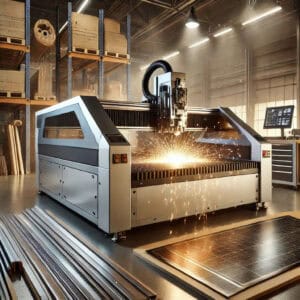News
Raw Materials for 3D Printers

The manufacturing world is constantly evolving thanks to technological innovations, and one of the most prominent developments in recent years is the growing and improving use of 3D printing for creating parts or complete items. In fact, 3D printing offers countless creative, technical, and industrial possibilities.
No less than the technology itself, the choice of raw materials plays a critical role in the printing process and its success.
The Importance of Raw Material Selection in 3D Printing
The raw materials used in printing not only determine the characteristics of the final product but also its durability, finishing quality, and suitability for its specific purpose. Using the right material for a project impacts the final result, the efficiency of the printing process, and the ability to meet the complex demands of the field.
While printing technologies continue to evolve, material selection remains one of the most critical steps in any project. This stage requires an in-depth understanding of the properties of different materials and their impact on the printing process.
Common Types of Raw Materials
A variety of raw materials are used in 3D printing, each with unique properties and uses:
- PLA (Polylactic Acid): A thermoplastic polymer made from corn, biodegradable, and environmentally friendly. Easy to print, available in various colors, and suitable for creating models, toys, and parts not exposed to high heat or heavy loads.
- ABS (Acrylonitrile Butadiene Styrene): A strong, heat-resistant material ideal for producing technical parts, consumer goods, tools, and vehicle components. Requires ventilation during printing.
- PETG (Polyethylene Terephthalate Glycol): Combines the ease of PLA with the strength of ABS. Resistant to chemicals, flexible, and easy to print. Suitable for creating containers, parts exposed to water or chemicals, and functional prototypes.
- Nylon (Polyamide): A strong, durable, and flexible material suitable for manufacturing mechanical parts, components in the automotive and aerospace industries, and functional prototypes. Requires controlled printing conditions.
- Resin: Primarily used in SLA and DLP printers, allowing the creation of objects with high precision and smooth finishes. Ideal for manufacturing jewelry, medical models, and complex prototypes.
What’s the Difference Between Home Printing and Industrial Printing Materials?
The materials used differ significantly between home and industrial printing, mainly due to the varying needs and demands of each field. In home printing, the most common materials are PLA and PETG. PLA is an easy-to-use, inexpensive material ideal for beginners and simple projects such as prototypes, toys, and decorative objects. PETG, on the other hand, offers higher resistance to heat and chemicals, making it suitable for more practical applications like creating containers and everyday tools.
Industrial printing, however, requires more advanced materials. Materials such as nylon, polycarbonate, and even metals are preferred due to their exceptional properties. For example, nylon is used in the automotive and aerospace industries to produce exceptionally strong and durable components. Polycarbonate is ideal for producing parts that withstand high temperatures, while metallic materials enable the production of functional components with maximum strength and precision.
Industrial printing is also characterized by expensive and advanced equipment designed to work with these materials, delivering high-quality results with physical properties tailored for professional uses. Choosing industrial materials enables the creation of functional parts for complex applications that require high precision, strength, and resistance to extreme conditions.
How to Choose the Right Material for Your Project?
Choosing the right raw material for 3D printing depends on the goals of the project and the properties required from the final product. The experts at Admati know how to choose the appropriate material for each 3D printing project based on the client’s needs and preferences.
Here are several important criteria:
- Mechanical Strength: If a strong, load-bearing product is required, materials like ABS or nylon are recommended.
- Heat Resistance: For products exposed to high temperatures, materials like ABS, polycarbonate, or nylon are suitable choices.
- Flexibility: When flexibility is required, TPU (Thermoplastic Polyurethane) or nylon are ideal choices.
- Surface Finish: To create objects with a smooth or highly precise finish, high-quality resins or PLA are recommended.
- Compliance with Standards: In projects in industries like medicine, aviation, or food, ensure that the material meets the relevant standards (e.g., FDA for food contact).
Examples of 3D Printing Applications with Different Materials
- PLA: Ideal for prototypes and creative projects, such as toys, models, and jewelry.
- ABS: Used for manufacturing durable technical parts, tools, and components in various industries.
- PETG: Suitable for products exposed to water or chemicals, such as containers, hydraulic connections, and lighting systems.
- Nylon: Perfect for mechanical parts like gears, industrial components, and parts in the automotive and aerospace fields.
- Resins: Allow precise manufacturing of jewelry, medical models, and highly complex prototypes.
Cost and Production Time in 3D Printing
Basic materials like PLA and PETG, commonly used in home printing, offer significant advantages in terms of cost and time. They are readily available, inexpensive, and easy to process, allowing for relatively quick production of simple parts. For example, printing a small plastic model can take just a few hours and incur very low costs.
In industrial printing, however, costs rise due to the use of more advanced materials. These are more expensive to purchase and require advanced equipment for the printing process. Moreover, printing complex components takes longer due to the need for precise modeling, high-quality finishing, and sometimes additional post-printing processing. For example, resins require further treatment for hardening and surface finishing, which extends the work time and increases costs.
The type of project also affects time and cost. Printing a simple prototype will cost less and be faster than printing functional parts for industries like automotive, aerospace, or medical. Proper planning of the printing process and the selection of suitable materials can help reduce costs and improve efficiency, but the specific project requirements must always be considered when making decisions.
Conclusion
The success of 3D printing largely depends on the correct selection of raw materials. Understanding the properties of materials and their suitability for the project requirements helps achieve optimal results, saves costs, and ensures durability and usability. For high-quality industrial 3D printing, contact Admati and receive expert investment in planning and research on raw materials, flawless execution, and a final product that fits its intended purpose.
More News Articles


